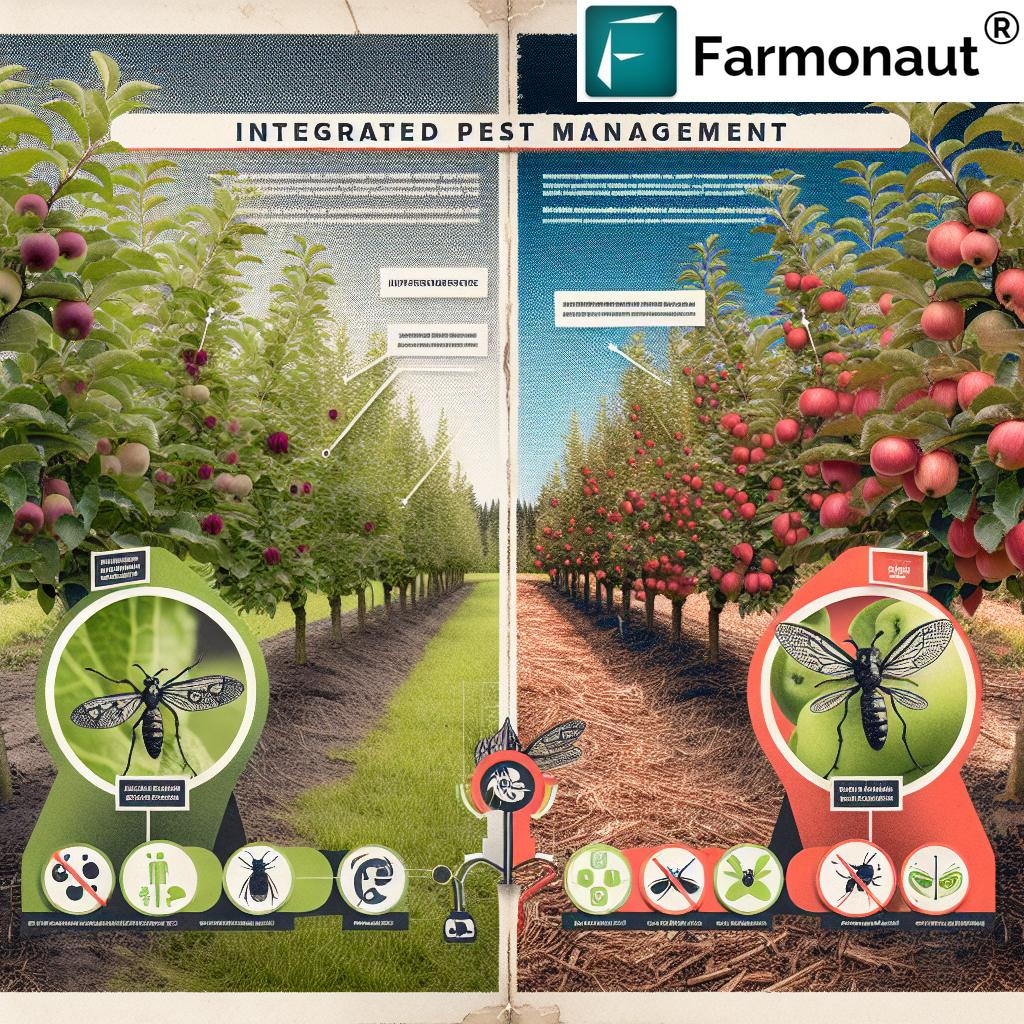Revolutionizing Canadian Cannabis: Precision Agriculture Meets Certified Genetics in Greenhouse Cultivation
“Canadian greenhouse cannabis cultivation has increased efficiency by up to 30% through precision agriculture techniques.”
Welcome to the cutting edge of cannabis cultivation in Canada! We’re excited to take you on a journey through the fascinating world of precision agriculture and certified genetics in greenhouse cannabis production. As experts in remote sensing and agricultural technology, we at Farmonaut are thrilled to explore how these innovations are transforming the Canadian cannabis industry.

The Green Revolution in Cannabis Cultivation
The Canadian cannabis industry has undergone a remarkable transformation in recent years. With the legalization of recreational cannabis in 2018, the sector has experienced unprecedented growth and innovation. At the forefront of this revolution is the marriage of precision agriculture and certified genetics in greenhouse cultivation.
Precision agriculture, a farming management concept based on observing, measuring, and responding to inter and intra-field variability in crops, has found a perfect application in cannabis cultivation. By leveraging advanced technologies such as satellite imagery, IoT sensors, and AI-driven analytics, growers can optimize every aspect of their operations.
The Role of Certified Genetics in Cannabis Production
Certified cannabis strains play a crucial role in ensuring consistent, high-quality products. These strains have undergone rigorous testing and certification processes to guarantee their genetic stability, potency, and desired characteristics. By using certified genetics, growers can:
- Ensure consistent cannabinoid and terpene profiles
- Improve crop uniformity and predictability
- Meet strict regulatory requirements
- Enhance product marketability and brand reputation
The combination of certified genetics and precision agriculture techniques has led to significant advancements in cannabis cultivation efficiency and product quality. Let’s delve deeper into how these technologies are reshaping the industry.
Greenhouse Technology: The Backbone of Modern Cannabis Cultivation
Greenhouse technology has become the backbone of modern cannabis cultivation in Canada. These controlled environments offer numerous advantages over traditional outdoor growing methods, including:
- Year-round production capability
- Protection from pests and adverse weather conditions
- Precise control over environmental factors
- Improved energy efficiency
- Enhanced biosecurity measures
Advanced greenhouse structures incorporate cutting-edge technologies such as automated climate control systems, LED lighting, and CO2 enrichment. These features allow growers to create the optimal conditions for cannabis plants to thrive, resulting in higher yields and better quality products.
Environmental Control Strategies in Cannabis Greenhouses
Effective environmental control is critical in cannabis greenhouse cultivation. Key factors that growers must manage include:
- Temperature and humidity levels
- Light intensity and spectrum
- Air circulation and CO2 concentration
- Nutrient delivery and pH balance
- Pest and disease management
By precisely controlling these factors, growers can optimize plant growth, maximize cannabinoid production, and ensure consistent quality across harvests. This level of control is made possible through the integration of advanced sensors, automated systems, and data analytics platforms.
At Farmonaut, we understand the importance of environmental monitoring in agriculture. Our satellite-based crop health monitoring system provides valuable insights into vegetation health, soil moisture levels, and other critical metrics. This data helps cannabis growers make informed decisions about irrigation, fertilizer usage, and pest management, ultimately optimizing crop yields and reducing resource wastage.
Precision Agriculture: Revolutionizing Cannabis Cultivation
Precision agriculture has revolutionized cannabis cultivation by introducing data-driven decision-making processes. This approach allows growers to:
- Optimize resource allocation
- Improve crop uniformity
- Reduce waste and environmental impact
- Increase overall production efficiency
One of the key technologies enabling precision agriculture in cannabis cultivation is remote sensing. Satellite imagery and drone-based sensors provide growers with valuable data on crop health, soil conditions, and environmental factors. This information allows for targeted interventions and more efficient resource management.
The Power of Data in Cannabis Cultivation
Data analytics plays a crucial role in modern cannabis cultivation. By collecting and analyzing data from various sources, including environmental sensors, growth metrics, and harvest results, growers can gain valuable insights into their operations. This data-driven approach enables:
- Predictive modeling for yield forecasting
- Early detection of plant stress or disease
- Optimization of growth cycles and harvest timing
- Continuous improvement of cultivation practices
Farmonaut’s Jeevn AI Advisory System is an excellent example of how AI-driven tools can support precision agriculture in cannabis cultivation. By analyzing satellite data and other inputs, Jeevn AI provides personalized farm advisory services, helping growers make informed decisions about crop management strategies.

Advanced Phenotyping Methods in Cannabis Breeding
“Over 200 certified cannabis strains are now available for commercial cultivation in Canada, thanks to advanced phenotyping methods.”
Phenotyping is a critical process in cannabis breeding and cultivation. It involves the systematic evaluation of plant characteristics to identify desirable traits. Advanced phenotyping methods have revolutionized the way breeders develop new cannabis varieties, leading to a wider range of certified strains available for commercial cultivation.
High-Throughput Phenotyping Technologies
Modern cannabis phenotyping employs a range of high-throughput technologies, including:
- Hyperspectral imaging for detailed plant analysis
- 3D scanning for precise morphological measurements
- Automated growth chambers for controlled environment studies
- Machine learning algorithms for rapid data processing and trait identification
These technologies allow breeders to quickly and accurately assess large populations of plants, accelerating the development of new strains with desired characteristics such as increased cannabinoid content, improved disease resistance, or enhanced terpene profiles.
Sustainable Greenhouse Management Practices
Sustainability is a key concern in modern cannabis cultivation. As the industry grows, it’s crucial to implement environmentally friendly practices that minimize resource consumption and reduce the overall carbon footprint. Some sustainable greenhouse management practices include:
- Water recirculation and purification systems
- Energy-efficient LED lighting
- Renewable energy integration (solar, wind, geothermal)
- Organic pest management strategies
- Biodegradable growing media and packaging materials
At Farmonaut, we’re committed to promoting sustainable agriculture. Our carbon footprint tracking feature helps agribusinesses monitor and reduce their environmental impact, providing real-time data on emissions and supporting efforts towards sustainability.
The Role of Biocontrols in Cannabis Cultivation
Biocontrols play a crucial role in sustainable cannabis cultivation. These natural pest management solutions include:
- Beneficial insects (e.g., predatory mites, ladybugs)
- Microbial agents (e.g., Bacillus thuringiensis)
- Botanical extracts with pest-repellent properties
- Trap crops and companion planting strategies
By implementing integrated pest management (IPM) programs that incorporate biocontrols, cannabis growers can reduce their reliance on chemical pesticides, improving product safety and environmental sustainability.
High-Quality Cannabis Production: From Seed to Sale
Producing high-quality cannabis requires attention to detail at every stage of the cultivation process. Let’s explore the key steps involved in bringing top-tier cannabis products to market:
1. Genetic Selection and Propagation
The journey begins with selecting certified genetics that meet specific quality and performance criteria. Growers may choose to start from seeds or use cloning techniques to propagate plants with desired traits. Advanced tissue culture methods are also becoming more common for large-scale propagation of elite cannabis genetics.
2. Vegetative Growth
During the vegetative stage, plants are provided with optimal conditions to develop strong root systems and vigorous foliage. Precision agriculture techniques, such as targeted nutrient delivery and spectral light manipulation, are employed to promote healthy growth and prepare plants for the flowering stage.
3. Flowering and Cannabinoid Production
The flowering stage is critical for cannabinoid and terpene production. Growers carefully control environmental factors to maximize the expression of desired compounds. Advanced lighting systems, including programmable LED fixtures, allow for precise manipulation of the light spectrum to influence plant metabolism and secondary metabolite production.
4. Harvest and Post-Processing
Timing is crucial when it comes to harvesting cannabis. Growers use a combination of visual cues and analytical tools to determine the optimal harvest window. Post-harvest processing, including drying, curing, and trimming, is carefully controlled to preserve the quality and potency of the final product.
5. Quality Control and Testing
Rigorous quality control measures are implemented throughout the production process. This includes regular testing for contaminants, potency analysis, and terpene profiling. Many Canadian cannabis producers have invested in on-site testing facilities to ensure rapid and accurate quality assessments.
Cannabis Industry Market Trends in Canada
The Canadian cannabis market continues to evolve rapidly. Some key trends shaping the industry include:
- Increasing demand for premium, craft cannabis products
- Growing interest in minor cannabinoids and rare terpene profiles
- Expansion of medical cannabis research and product development
- Rising adoption of sustainable and organic cultivation practices
- Integration of blockchain technology for supply chain transparency
Farmonaut’s blockchain-based traceability solution is particularly relevant in this context, as it enables transparency and trust in cannabis supply chains. This technology ensures that every stage of the product’s journey, from cultivation to consumer, is documented and verifiable.
The Future of Cannabis Cultivation Technology
Looking ahead, we can expect to see continued innovation in cannabis cultivation technology. Some areas of development to watch include:
- Advanced AI-driven growth optimization systems
- Gene editing techniques for enhanced trait development
- Novel lighting technologies for improved energy efficiency
- Vertical farming solutions for urban cannabis production
- Integration of robotics and automation in cultivation and processing
These advancements will further improve the efficiency, sustainability, and quality of cannabis production in Canada and beyond.
Comparative Analysis of Cannabis Cultivation Methods
| Cultivation Method | Yield Potential | Environmental Control | Genetic Consistency | Resource Efficiency | Market Value |
|---|---|---|---|---|---|
| Outdoor Cultivation | Low-Medium | Limited | 70% | Low | Low-Medium |
| Basic Greenhouse | Medium-High | Moderate | 85% | Medium | Medium-High |
| Advanced Greenhouse with Precision Agriculture | Very High (+30%) | Extensive | 95% | High (40% water savings) | Premium |
This table clearly illustrates the advantages of advanced greenhouse cultivation with precision agriculture techniques. The significant improvements in yield potential, genetic consistency, and resource efficiency demonstrate why this approach is becoming increasingly popular among Canadian cannabis producers.
The Role of Technology in Cannabis Cultivation
Technology plays a pivotal role in modern cannabis cultivation, enabling growers to achieve unprecedented levels of efficiency and quality. Some key technological advancements include:
1. IoT Sensors and Automation
Internet of Things (IoT) sensors are deployed throughout cannabis greenhouses to monitor various environmental parameters in real-time. These sensors feed data into automated control systems that adjust lighting, temperature, humidity, and irrigation as needed. This level of automation ensures optimal growing conditions are maintained 24/7, reducing labor costs and human error.
2. Machine Learning and Predictive Analytics
Machine learning algorithms analyze vast amounts of cultivation data to identify patterns and make predictions. This technology can help growers anticipate plant needs, optimize resource allocation, and even predict potential issues before they occur. Predictive analytics are particularly useful for scheduling harvests and managing supply chain logistics.
3. Computer Vision for Plant Health Monitoring
Advanced computer vision systems use high-resolution cameras and AI algorithms to detect early signs of plant stress, nutrient deficiencies, or pest infestations. These systems can analyze thousands of plants quickly and accurately, allowing for timely interventions to maintain crop health.
Challenges and Opportunities in Canadian Cannabis Cultivation
While the Canadian cannabis industry has made significant strides, it still faces several challenges and opportunities:
Challenges:
- High energy consumption and associated costs
- Strict regulatory compliance requirements
- Managing pest and disease pressures in large-scale operations
- Balancing automation with skilled labor needs
- Addressing consumer concerns about pesticide use and product safety
Opportunities:
- Expansion into international markets as global cannabis regulations evolve
- Development of novel cannabis-based products for medical and recreational use
- Integration of renewable energy sources to reduce operating costs and environmental impact
- Collaboration with research institutions to advance cannabis science and breeding techniques
- Leveraging e-commerce and direct-to-consumer models for increased market reach
At Farmonaut, we’re committed to helping cannabis growers navigate these challenges and capitalize on opportunities. Our satellite and weather API provides valuable data that can be integrated into cultivation management systems, supporting data-driven decision-making and operational optimization.
The Impact of Cannabis Cultivation on the Horticulture Industry
The rapid growth of the cannabis industry has had a significant impact on the broader horticulture sector. Some notable effects include:
- Accelerated development of advanced greenhouse technologies
- Increased investment in horticultural research and development
- Creation of new job opportunities in agriculture and related fields
- Spillover of cannabis cultivation techniques to other high-value crops
- Growing demand for specialized horticultural equipment and supplies
These developments have led to a cross-pollination of ideas and technologies between cannabis cultivation and traditional horticulture, driving innovation across the entire agricultural sector.
Conclusion: The Future of Canadian Cannabis Cultivation
The Canadian cannabis industry stands at the forefront of agricultural innovation, combining precision agriculture techniques with certified genetics to produce high-quality products in state-of-the-art greenhouses. As the industry continues to evolve, we can expect to see further advancements in technology, sustainability practices, and product development.
At Farmonaut, we’re excited to be part of this green revolution, providing cutting-edge tools and insights to support the growth of the cannabis sector. Whether you’re a small-scale grower or a large commercial operation, our satellite-based farm management solutions can help you optimize your cultivation practices and stay ahead in this dynamic industry.
To learn more about how Farmonaut can support your cannabis cultivation efforts, check out our API Developer Docs or download our mobile apps:
FAQs
- What are the main advantages of greenhouse cannabis cultivation over outdoor growing?
Greenhouse cultivation offers year-round production, better environmental control, protection from pests and adverse weather, improved energy efficiency, and enhanced biosecurity. - How does precision agriculture benefit cannabis growers?
Precision agriculture enables optimized resource allocation, improved crop uniformity, reduced waste, and increased overall production efficiency through data-driven decision-making. - What role do certified genetics play in cannabis production?
Certified genetics ensure consistent cannabinoid and terpene profiles, improve crop uniformity and predictability, meet regulatory requirements, and enhance product marketability. - How are advanced phenotyping methods changing cannabis breeding?
Advanced phenotyping technologies like hyperspectral imaging and 3D scanning allow breeders to quickly and accurately assess large plant populations, accelerating the development of new strains with desired characteristics. - What are some key sustainable practices in cannabis greenhouse management?
Sustainable practices include water recirculation systems, energy-efficient LED lighting, renewable energy integration, organic pest management, and use of biodegradable materials.















